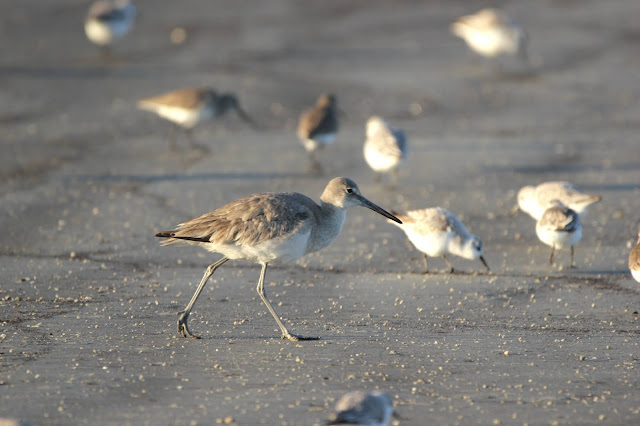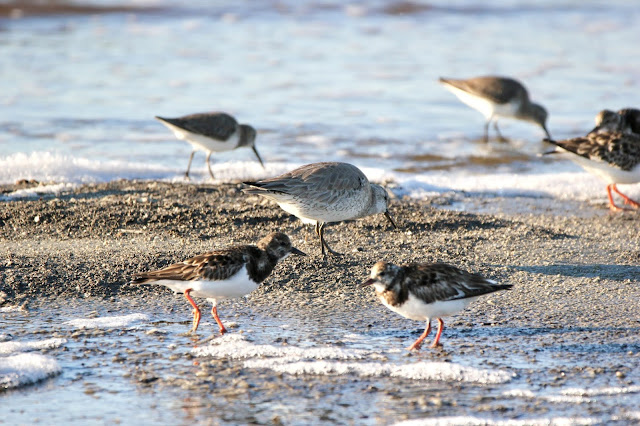Jekyll Island's mandate that only 35% of the island can be developed has proven to be a boon for birds on the island. Shorebirds especially have benefitted from the lack of development and are found throughout the unspoiled beaches on this island. One of the best places to go searching for shorebirds is the Jekyll Island south beach. This beach is at the southernmost point of the island and is the exact opposite of Miami's South Beach, in which there is absolutely no development on this portion of the island. Countless shore birds congregate at this point during all times of day but are especially numerous during high tide.
 |
| A Willet surrounded by Dunlin and Sanderlings during the morning of March 4 on the Jekyll Island South Beach. Keep an eye on the photos below where I include a photo of a specific type of bird next to another species or two to help with reference. In particular, the Dunlin seemed to be the reference bird in many of these photos and a good comparison to gauge size of these other birds to each other. |
 |
| A large mixed flock of shorebirds in the afternoon of March 4 at the South Beach |
 |
| An inquisitive Herring Gull surrounded by feeding Sanderlings. |
I visited this part of the island on two separate occasions on the same day. The first time was in the morning on Thursday, March 4 before our bird ramble with Lydia Thompson. At this time the ocean was at low tide and the shorebirds in this area were actively searching for tasty morsels underneath the wet sand.
 |
| A Willet towering over the nearby Sanderlings (white) and Dunlin (brown with longer beaks). The key with shorebirding is to compare bird sizes relative to other birds nearby.. |
 |
| Three Willets taking a stroll |
 |
| A Willet perusing the beach. |
When I arrived in the morning, I was overwhelmed at the diversity of shorebirds on site. I realized that I clearly did not study shorebirds enough and had a lot of difficulty identifying them. Fortunate for me, these birds were very willing to be photographed which would allow me time to review the photos that I took while out at the south beach with Lydia and Pricilla before our bird ramble. Their expertise on shorebirds along with extensive reviewing of my Crossley Guide gave me the tools I needed to successfully identify these amazing birds.
 |
| A Dunlin (long legs and beak) next to some nearby Ruddy Turnstones (orange legs) |
 |
| Sanderlings feeding near a larger Dunlin (brown; in the background) |
 |
| A Dunlin probing into the surf. |
 |
| A Sanderling (foreground) and Dunlin (background) feeding on the shore. |
 |
| Dunlin and Ruddy Turnstones. |
The early morning out on this beach was filled with Willets, Dunlins, Sanderlings, Ruddy Turnstones, a Red Knot, and the prize for the morning: a Wilson's Plover. What Lydia and Priscilla taught me after the fact is that to find this neat bird that nests on the island is you need to look towards land instead of toward the ocean like you do for other shorebirds. Looking back, I am still thrilled that I was able to stumble upon this stunning bird that has been in decline due to beach disturbance and development along the southeast coast.
 |
| A male Wilson's Plover. |
 |
| A male Wilson's Plover. |
 |
| A female Wilson's Plover. |
|
 |
A female Wilson's Plover.
|
After our three hour bird ramble and an hour of shorebirding, I was itching to get out there again because I missed one of the birds I wanted to see most besides the Painted Bunting and Yellow-Throated Warbler: the American Oystercatcher. Lydia mentioned to me that it would be best timing to find oystercatchers at high tide at the south beach. Fortunately timing was in my favor that high tide was right after Molly's and my bird ramble. I dropped Molly off back at our villa for her to rest after three hours birding with Lydia and Priscilla and raced out to the south beach to find these oystercatchers before our planned tour of the historic district of Jekyll Island in the mid-afternoon.
 |
| A large Red Knot (gray) feeding next to some Ruddy Turnstones (orange legs) and Dunlin (background with long beaks and black legs) |
 |
| If I ever started a rock band, I think the Ruddy Turnstones would be a great name. |
 |
| The Ruddy Turnstones were my favorite shorebird sighting in the morning for due to their beautiful coloration. Let’s find out if the afternoon will produce the prize shorebird I was seeking: the American Oystercatcher. |
The scene at high tide was a lot different than low tide. During low tide, the shorebirds were scrambling to find food in the wet sand. Now, this wet sand that fed these birds was covered with the high tide giving these birds a nice time for an afternoon nap. Nearly a dozen American Oystercatchers were taking a break at the south beach providing for some great photo opportunities. Forster's Terns and Royal Terns also were nice additions to the birds that I had not been able to see during low tide but were resting on the beach during high tide. Laughing Gulls (not found in Michigan) and Ring-Billed Gulls also found time to rest on the beach.
 |
| Some Laughing Gulls next to a short-legged and big-bodied Caspian Tern (background) |
 |
| Some Laughing Gulls next to some small Forster's Terns. |
 |
| Caspian Terns behind primarily Dunlin. These birds are what Molly and I affectionately call "George Costanza Birds" due to their bald appearance. |
“For I am Costanza, Lord of the Idiots." - George the Tern
"I come from a long line of quitters. My father was a quitter, my grandfather was a quitter. I was raised to fail." - George the Tern, telling a disinterested and neck-bending Forster's Tern.
 |
| George the Tern telling the nearby Terns a story: "The sea was angry that day my friends, like an old man trying to return soup at a deli!" |
 |
| Forster's Tern near some Caspian Terns. |
The remaining shorebirds that I was hoping to find were Black-Bellied Plovers, Semipalmated Plovers, Least Sandpipers, Western Sandpipers, and Short-Billed Dowitchers. My last chance to find them was on the way out of Jekyll Island on Friday, March 5, and if I did find these birds, my life list for birds would exceed 200 total species. The next blog post will let you know if I ended up being successful in my pursuit for these shorebirds and my 200th species or if I would go home empty handed.
 |
| Some Willets near some American Oyster Catchers. |
 |
| American Oystercatchers were one of the birds I wanted to see before leaving Jekyll Island. I am a big fan of the long orange beaks used to crush oysters/mollusks and their red eye ring/yellow eye. |
 |
| American Oystercatchers resting on one leg. |
 |
| American Oystercatchers behind some Dunlin. |
Video of South Beach during the afternoon of March 4, 2021.

































Good to see that you took your talents to South Beach.
ReplyDeleteI expected those Caspian Terns to look a little smaller due to shrinkage.